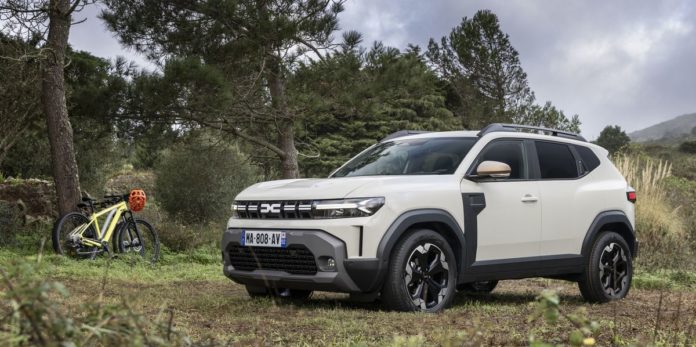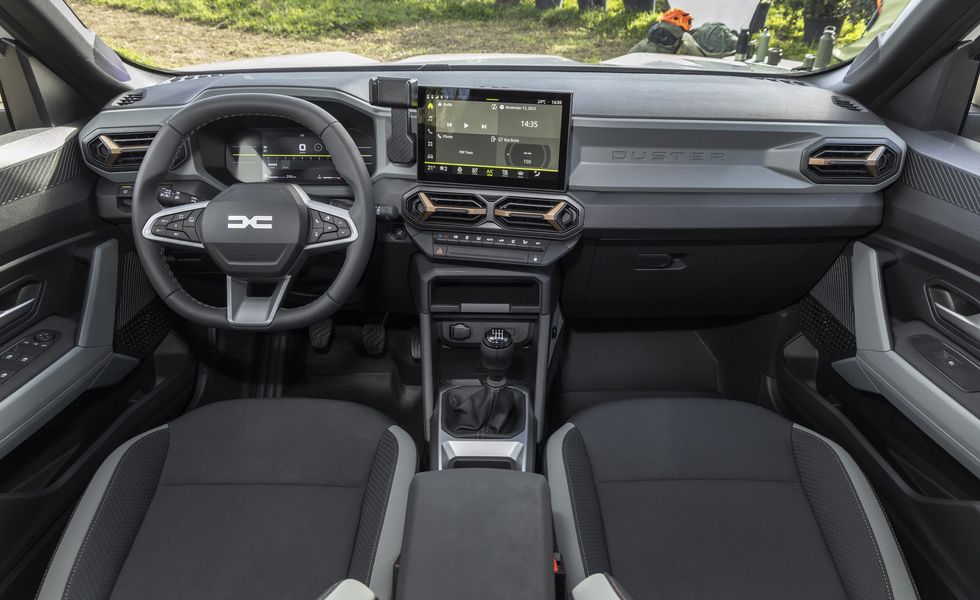- Dacia, owned by Renault, has revealed a new Duster, which appears to carry on the same cheap-but-capable mantra of the outgoing model.
- The new Duster looks far more distinctive, however, with expressive lighting and a tough stance.
- The Duster comes with two different hybrid powertrains as well as an unusual one that can run on gasoline and liquified petroleum gas (LPG).
It may share its name with a 1970s Plymouth muscle car, but the Dacia Duster is a very different beast. This compact SUV from the Romanian Renault subsidiary has been a massive success in Europe since its launch in 2010, with 2.2 million units built so far, as it has carved out a reputation as an affordable off-roader. The new 2024 Duster looks to maintain that status while adding a healthy dose of style to the mix. Unfortunately, it won’t be sold in America.
Fresh Design
The outgoing Duster wasn’t ugly, but it certainly looked anonymous. The new design is chiseled and assertive, with bold Y-shaped graphics in the headlights and taillights. Front and rear skid plates protect important powertrain components and the all-terrain character is enhanced by beefy wheel arches. The Extreme trim (show in these photos) features copper accents.
Dacia describes the black trim as a “belt” that shields the vehicle from dents and dings, wrapping from the bumpers around the sides and up the front edge of the front doors. This trim is fashioned from a new material developed by Dacia called Starkle, which contains up to 20 percent reused polypropylene. It is left unpainted, reducing the vehicle’s carbon footprint, and Dacia says the lack of paint makes scratches less noticeable. Around 20 percent of all of the plastic in the Duster is recycled, and Dacia touts the eco-friendly merits of the lack of decorative chrome and real leather (also a convenient way to keep costs low). Even the user manual uses less paper than before.
Inside, the cabin blends Dacia’s down-to-earth, low-cost feel with modern elements that prevent it from feeling like a dour econobox. The use of straight lines and sharp angles brings a visual robustness that is backed up by a washable fabric upholstery on the Extreme trim and rubber floor mats, 20 percent of which come from recycled materials.The air vents borrow the Y-shaped motif from the headlights, and the 10.1-inch central touchscreen is angled toward the driver and supplemented by a 7.0-inch digital gauge cluster.
Under the Hood
Dacia offers an array of powertrains. The Hybrid 140 pairs a 94-hp 1.6-liter four-cylinder with a pair of electric motors; one serves as a high-voltage starter-generator and the other sends 49 hp to the wheels. A 1.2-kWh battery provides the juice, and with the regenerative brakes, Dacia says the Duster can drive in all-electric mode up to 80 percent of the time. This powertrain is connected to a four-speed automatic gearbox.
The TCe 130, meanwhile, combines a turbocharged 1.2-liter three-cylinder with a 48-volt electric motor and a 0.8-kWh battery to improve fuel efficiency and help with acceleration. A six-speed manual is the only gearbox available on both the front- and four-wheel-drive versions of the 130. Lastly, the Duster offers the ECO-G 100, a turbo 1.0-liter three-cylinder that packs two 13.2-gallon tanks, one of which holds gasoline and another that holds liquefied petroleum gas (LPG). Dacia claims that running on LPG releases 10 percent less carbon dioxide than gasoline, and the Duster can switch between the two fuel sources at the press of a button.
Owners who wish to leave the pavement will be helped by a terrain-control function fitted to 4×4 models that has five modes, including Snow, Mud/Sand, and Eco, which redistributes torque to the front and rear axles to limit fuel consumption while still providing the requisite grip. Four-wheel-drive Dusters have 8.5 inches of ground clearance, and the rugged little ute boasts a 31 degree approach angle and 36 degree departure angle. There’s also a hill-descent-control function, and the central screen displays vital off-road-relevant information.
Dacia is offering outdoorsy accessories, including a roof rack that easily snaps onto the roof bars and can hold up to 176 pounds. There is also the Sleep Pack, a removable box that includes a fold-out 6.2-by-4.2-foot bed, a tray table, and a storage cubby. Dacia says it takes just two minutes to convert the Sleep Pack from a box to a bed.
Prices haven’t been revealed, but Dacia promises to offer “the most affordable prices in its segment.” Sadly, those low prices will never be converted into U.S. dollars, as the Duster will remain forbidden fruit, sold mainly in Europe and Latin America, where it has been badged as a Renault in the past.
Associate News Editor
Caleb Miller began blogging about cars at 13 years old, and he realized his dream of writing for a car magazine after graduating from Carnegie Mellon University and joining the Car and Driver team. He loves quirky and obscure autos, aiming to one day own something bizarre like a Nissan S-Cargo, and is an avid motorsports fan.




